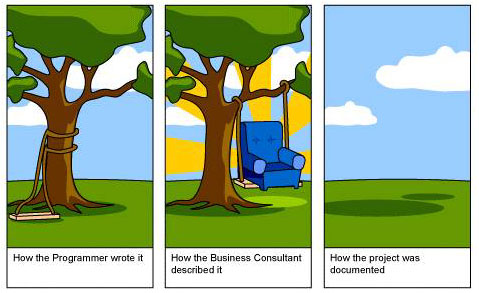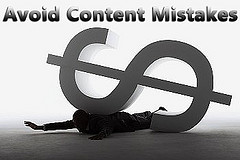|
|
|
Wednesday, April 24th, 2019

Considering the examples of bad writing in Monday’s and Tuesday’s posts it’s obvious that much of the problem comes down to a lack of clarity.
No surprise there, but other than confusing everyone, bad writing easily morphs into no writing, which can be a disastrous to product development, especially in tech.
As the image above shows, lack of writing skills impact every part of a sale, but lack of documentation is probably the worst.
Think about it. Things go wrong with equipment all the time and when it does you go to the manual to see how to fix it.
Software is even worse.
With minimal-to-no documentation, fixing bugs, iterating and keeping legacy software running is extremely difficult, especially if the primary developers leave the company.
No matter your education or experience, if you can write coherently you will have a serious edge over other candidates.
Image credit: Jhayne
Posted in Communication, Personal Growth | No Comments »
Friday, June 13th, 2014
A Friday series exploring Startups and the people who make them go. Read all If the Shoe Fits posts here
 Yesterday we looked at content problems associated with over-familiarity with your products/services and that same over-familiarity can weaken your investor pitch. Yesterday we looked at content problems associated with over-familiarity with your products/services and that same over-familiarity can weaken your investor pitch.
Investors are similar to customers in terms of what they want to know—the difference is viewpoint.
- Where customers want to know what your product/service will do to solve their problem, investors want to know how many have the problem, in other words, how large is the market.
- Customers don’t care about your technology/IP; neither do investors other than to be sure that it is unique and protected, i.e., patented or, at least, patent pending.
- Customers love it when you save them something—money, time, effort—investors love it when you make them something— money.
These days investors are far more focused on “how will you make money,” as opposed to “how will you acquire users.”
This is especially true if you are pitching a web service.
Bottom line; talk tech to the people you hang with, talk money and market to your investors.
Image credit: HikingArtist
Posted in Communication, If the Shoe Fits | No Comments »
Thursday, June 12th, 2014
 One of the biggest problems I run into when I work with startups is what I call “familiarity blindness.” One of the biggest problems I run into when I work with startups is what I call “familiarity blindness.”
I see it most frequently in the content I am asked to revamp, but also occasionally in the products/services themselves.
Familiarity blindness is the result of being immersed in an idea at its most basic level from conception on and the result is often a version of not seeing the forest for the trees.
Typically, tech entrepreneurs are in love with their tech. They love to talk about it and it often forms the basis for discussion with their peers.
What tech entrepreneurs often have trouble accepting is that most customers don’t care.
That’s why it’s so important to know how your product/service is actually viewed by your market and that means getting out of the incubator or coffee house into the real world and talking to your target audience—not just talking, but really listening to what they say. (See yesterday’s post for help identifying and understanding your value proposition.)
When it comes to content, for your website, ads, articles, etc., “less is definitely more.”
Skip the technology, no matter how cool or groundbreaking, or even what it does, unless you are talking about what it does for your users/customers.
The exceptions are articles and interviews with technical media and even then what it does is usually more important than the technical description of how it does it.
Generally speaking, the only thing your potential users/customers care about is how your product/service will benefit them.
And they want to know quickly and painlessly and to understand with little mental effort on their part required.
Join me tomorrow for a look at familiarity blindness when pitching.
Flickr image credit:
Posted in Communication, Entrepreneurs | No Comments »
Wednesday, May 28th, 2014

A LinkedIn post reminded me of something we all too often forget.
I’ve learned that the number one rule in sales is everybody wants what everybody wants and nobody wants what nobody wants. When you tell a buyer they can’t have something, they always want it more, but let that same customer know there’s plenty to go around and they’ll always go home to think about it.
It may be in the back of our minds, but we dance too much.
We spend time finding the fanciest or trendiest words to describe it.
Worse, we use ‘in’ words and industry-specific terms.
If the customer isn’t familiar with the language we choose she will spend her time puzzling out the meaning instead of buying.
Or she’ll just leave for a friendlier source.
Don’t get me wrong. Great stories that display the sexiness/romance/usefulness/value of your product or service are good—in their proper place.
But nothing projects authenticity, builds trust and creates urgency as perfectly as true clarity.
Flickr image credit: Alpha
Posted in Communication, Hiring | No Comments »
Monday, September 16th, 2013
 I read an article in ADWEEK explaining why any content a company creates should be considered marketing and the importance it all has to building the brand. I read an article in ADWEEK explaining why any content a company creates should be considered marketing and the importance it all has to building the brand.
Content is marketing, we all know that. But marketing is also content. So are HR manuals, social media policies, annual reports, analyst reports, research studies, customer evaluations, product reviews, employee testimonials, customer testimonials, videos from conferences, CEO blogs, tweets, updates and check-ins.
The article reminded me of something I wrote last year that dovetails perfectly.
Why are so many blogs and biz books overwritten; saying the same thing over and over as if repeating the message for an extra hundred or more pages will make it more powerful?
Even fiction often follows the same pattern.
Why is so much content garbage?
Why do people insist that more is better?
Why do they assume that using a word with multiple syllables will make them sound more intelligent and impress the reader?
Websites are worse, both B2B and especially B2C.
Way overwritten and in long dense paragraphs with the vital information buried.
Has it gone completely unnoticed that almost nobody reads anymore?
The majority scan and in a hurry, spending 5-10 seconds to decide if they want to spend the average of 30 seconds on that page.
And those of us who do read are easily annoyed by bad design and the garbage that passes for content.
The problem, of course, is that a healthy ‘data-ink ratio’, which means saying a lot clearly in as few words as possible, is hard work.
I probably shouldn’t complain since I offer a service called Clarity REwriting that contributes significantly to my revenues, but still.
It’s easy to avoid dense, opaque, overwritten books and blogs, but when I need information from a website I am stuck.
So do yourself (and me) a favor.
Think about the data-ink ratio when you develop your content; doing so will improve your business.
I’ll add that consideration applies just as much to your internal docs.
Some of the worst examples come from HR, but it’s often not their fault, since so much HR content is developed by lawyers and very few of employees are fluent in legalese.
DISCLAIMER: What follows is an ad.
If you need assistance with the clarity of your content call or write me (the contact info is in the right hand column); you’ll find I’m fast and more affordable than you might imagine.
Flickr image credit: 10ch
Posted in Communication | No Comments »
Wednesday, July 24th, 2013
 When Microsoft announced its much ballyhooed new strategy and resulting management changes I commented that you can’t change culture, especially an intentionally siloed culture, by edict. When Microsoft announced its much ballyhooed new strategy and resulting management changes I commented that you can’t change culture, especially an intentionally siloed culture, by edict.
I didn’t go into what seemed to me a strategy with a serious lack of solid content; these days we all know that not only is content king, but the it’s source of authenticity.
I assumed that it was my unwillingness (boredom) to read the analysis offered by media, let alone Steve Ballmer’s actual long-winded statement to the Microsofties, that made me miss it.
As has been said over and over by experts, “culture eats strategy for lunch” (breakfast, in come cases), and while clear communications is as great a focus for me as culture, I just couldn’t make myself read it.
Fortunately, Wally Bock at Three Star Leadership has more patience and he offered some great analysis and comments, which are reposted below with his kind permission.
Microsoft and the Strategy of Everything
On July 13, 2013, Microsoft’s CEO, Steve Ballmer sent a lumbering, poorly edited, 2600 word email to Microsoft employees, announcing the company’s new strategy. As awful as the memo was, the strategy is worse.
When I read some of the news accounts, I felt like I was experiencing an updated version of Akira Kurosawa’s classic, Rashomon. In that film, people who participate in the same event each describe it differently. In this case, news organizations that got the same information each describe Microsoft’s new strategy differently.
The New York Times wrote about how “Microsoft Overhauls, the Apple Way.” The Wall Street Journal looked at the same announcement and said that “Microsoft Shake-Up Aims to Speed Products.” And the Mercury News told us that “Microsoft unveils major overhaul in effort to focus on mobile.”
Those very different reports sent me to the Microsoft site and the text of Steve Ballmer’s email. There, he tells us that “We are rallying behind a single strategy as one company.” Sounds good. And what might that single strategy be? Here goes.
“Going forward, our strategy will focus on creating a family of devices and services for individuals and businesses that empower people around the globe at home, at work and on the go, for the activities they value most.”
Try reading that without taking a breath or tripping over tangled syntax. Doesn’t exactly have the ring of “A PC on every desk and in every home” does it?
As I interpret it, Microsoft will make products and provide services which they will sell to individuals and businesses in the US and other countries. Egad! Is there anything Microsoft has chosen not to do?
There’s no focus at all. Being everything to everyone is usually a pretty sure way not to be much of anything to anybody.
And there’s nothing to fire up the passions that drive engagement. Would you really leap out of bed in the morning all charged up to “focus on creating a family of devices and services for individuals and businesses?”
This is not a strategy to build long term, sustainable competitive advantage. It is a strategy for rotting slowly from the inside out.
Thanks, Wally.
Flickr image credit: Masaru Kamikura
Posted in Communication, Culture, Strategy | No Comments »
Friday, May 4th, 2012
A Friday series exploring Startups and the people who make them go. Read all If the Shoe Fits posts here
 You’re a founder and you have a vision. You’re a founder and you have a vision.
You tell people about your vision with an eye to recruiting them as investors or employees or customers.
While it’s important that your vision be enticing it’s more important that it dazzle with its clarity.
Clarity is not easy, which is why elevator pitches and tag lines are so difficult to do.
Most people start with a highly embellished description and work to reduce/clarify it.
The reverse is often easier.
Start with a truly bare bones version, such as this description of a restaurant.
“We buy food. We fix it up. And we sell it at a profit.” – Celebrity Chef Mario Batali**
Then add embellishments slowly, one at a time and get feedback with each iteration.
But avoid getting all the feedback from the same audience.
Each time people hear it they add knowledge and reference, and context to their unconscious database, so in time they start interpolate and filling in the blanks just as you do.
Hence you need to constantly refresh your audience to achieve viable feedback, but that unconscious database is the bane of working with anything over the long haul,
The point of all this is to remind you to clarify your vision before you start to sell it.
Option Sanity™ is plain-spoken and direct.
Come visit Option Sanity for an easy-to-understand, simple-to-implement stock allocation system. It’s so easy a CEO can do it.
Warning.
Do not attempt to use Option Sanity™ without a strong commitment to business planning, financial controls, honesty, ethics, and “doing the right thing.”
Use only as directed.
Users of Option Sanity may experience sudden increases in team cohesion and worker satisfaction. In cases where team productivity, retention and company success is greater than typical, expect media interest and invitations as keynote speaker.
**Hat tip to Wally Bock for the Mario Batali quote.
Flickr image credit: HikingArtist
Posted in Entrepreneurs, If the Shoe Fits | 2 Comments »
Monday, February 27th, 2012
 Why are so many blogs and biz books overwritten; saying the same thing over and over as if repeating the message for an extra hundred or more pages will make it more powerful? Why are so many blogs and biz books overwritten; saying the same thing over and over as if repeating the message for an extra hundred or more pages will make it more powerful?
Even fiction often follows the same pattern.
Why is so much content garbage?
Why do people insist that more is better?
Why do they assume that using a word with multiple syllables will make them sound more intelligent and impress the reader?
Websites are worse, both B2B and especially B2C.
Way overwritten and in long dense paragraphs with the vital information buried.
Has it gone completely unnoticed that almost nobody reads anymore?
The majority scan and in a hurry, spending 5-10 seconds to decide if they want to spend the average of 30 seconds on that page.
And those of us who do read are easily annoyed by bad design and the garbage that passes for content.
The problem, of course, is that a healthy ‘data-ink ratio’, which means saying a lot clearly in as few words as possible, is hard work.
I probably shouldn’t complain since I offer a service called Clarity REwriting that contributes significantly to my revenues, but still.
It’s easy to avoid dense, opaque, overwritten books and blogs, but when I need information from a website I am stuck.
So do yourself (and me) a favor.
Think about the data-ink ratio when you develop your content; doing so will improve your business.
DISCLAIMER: What follows is an ad.
If that’s too much work call or write me (the contact info is in the right hand column); you’ll find I’m fast and more affordable than you might imagine.
Flickr image credit: Beck Tench
Posted in Communication | No Comments »
Tuesday, November 29th, 2011
 Today’s post is short because reading the articles to which it’s linked is critical. Today’s post is short because reading the articles to which it’s linked is critical.
Are you a good communicator? Do you provide clear, complete, timely information to your team? Do you ever worry that it’s not as understandable as you think?
Have you ever read or heard a professional communicator and wished you could do that, too?
You would expect the two top people of an innovation consultancy to be good communicators and not make the assumption mistake.
They recently wrote an article in Business Week describing the three types of people to fire immediately if you want to increase innovation in your company.
The article was the most read for eight days and generated in excess of 1000 comments, mostly negative.
Why?
Because the way the article reads it’s the workers who should be fired, not the bosses.
So they wrote an apology and explanation.
“And that brings us to the ultimate irony. When we talked about firing people, we were thinking about those higher on the org chart, not lower. We meant the boss and senior management team. … We thought we made this implicit in the article. Judging from the response, we didn’t. We should have made it clearer.”
Communicating takes effort and the number one rule of clarity is no assumptions.
Read the articles and save them to read again whenever you find a disconnect between what you communicate and your team’s actions to be sure that you aren’t the source of the problem.
Flickr image credit: zedbee
Posted in Communication, Ducks In A Row | 1 Comment »
Friday, October 28th, 2011
 A Friday series exploring Startups and the people who make them go. Read all If the Shoe Fits posts here A Friday series exploring Startups and the people who make them go. Read all If the Shoe Fits posts here
A young programming whiz called me after reading this post and requested some help.
“Jim” had job offers from two strong startups and wasn’t sure which to accept.
I discussed which technology he found most interesting, which position he thought would be the most challenging, where he thought he would learn the most, which people he felt most comfortable with, which company seemed to have values/culture that was most synergistic to his own.
I asked if there was anything about either one that bothered him and Jim said that was the problem, he wasn’t sure.
In both cases, his final interview had been with the respective founders. Both shared their vision and seemed open when responding to his questions. He left each feeling excited and enthralled with the opportunities.
Jim said the problem surfaced when he was telling his parents about the companies (call them A and B).
He said he was easily able to explain B’s vision, market, opportunity and even culture, but when he tried to describe A’s vision and the founder’s answers to his questions he couldn’t.
What seemed so clear when they were talking wasn’t when he used his own words to explain it to his folks.
When he replayed the founder’s actual sentences and even wrote them out and re-read it they didn’t make as much sense—worse, some didn’t make any sense at all.
What happened to Jim made me think of a recent post by Steve Roesler about keeping things simple.
Truth comes in sentences. B_ llS_it comes in paragraphs. If you can’t say it with a noun, verb, and object, you aren’t clear about your thought.
I suggested he read it and also yesterday’s post and apply the information to the problem.
Jim just emailed me to thank me for the time we spent and the links; he also said that he had accepted B’s offer.
Which do you remind your candidates of, A or B?
Option Sanity™ makes ISO allocation transparent.
Come visit Option Sanity for an easy-to-understand, simple-to-implement stock process. It’s so easy a CEO can do it.
Warning!
Do not attempt to use Option Sanity™ without a strong commitment to business planning, financial controls, honesty, ethics, and “doing the right thing.” Use only as directed.
Users of Option Sanity may experience sudden increases in team cohesion and worker satisfaction. In cases where team productivity, retention and company success is greater than typical, expect media interest and invitations as keynote speaker.
Image credit: Bun in a Can
Posted in Entrepreneurs, Hiring, If the Shoe Fits | No Comments »
|
 Subscribe to
Subscribe to
MAPping Company Success
About Miki 
Clarify your exec summary, website, etc.
Have a quick question or just want to chat? Feel free to write or call me at 360.335.8054
The 12 Ingredients of a Fillable Req
CheatSheet for InterviewERS
CheatSheet for InterviewEEs™
Give your mind a rest. Here are 4 quick ways to get rid of kinks, break a logjam or juice your creativity!
Creative mousing
Bubblewrap!
Animal innovation
Brain teaser
The latest disaster is here at home; donate to the East Coast recovery efforts now!
Text REDCROSS to 90999 to make a $10 donation or call 00.733.2767. $10 really really does make a difference and you'll never miss it.
And always donate what you can whenever you can
The following accept cash and in-kind donations: Doctors Without Borders, UNICEF, Red Cross, World Food Program, Save the Children
*/
?>About Miki
About KG
Clarify your exec summary, website, marketing collateral, etc.
Have a question or just want to chat @ no cost? Feel free to write
Download useful assistance now.
Entrepreneurs face difficulties that are hard for most people to imagine, let alone understand. You can find anonymous help and connections that do understand at 7 cups of tea.
Crises never end.
$10 really does make a difference and you’ll never miss it,
while $10 a month has exponential power.
Always donate what you can whenever you can.
The following accept cash and in-kind donations:
|






 One of the biggest problems I run into when I work with startups is what I call “familiarity blindness.”
One of the biggest problems I run into when I work with startups is what I call “familiarity blindness.”

 When Microsoft announced its much ballyhooed new strategy and resulting management changes I commented that you
When Microsoft announced its much ballyhooed new strategy and resulting management changes I commented that you  Why are so many blogs and biz books overwritten; saying the same thing over and over as if repeating the message for an extra hundred or more pages will make it more powerful?
Why are so many blogs and biz books overwritten; saying the same thing over and over as if repeating the message for an extra hundred or more pages will make it more powerful? Today’s post is short because reading the articles to which it’s linked is critical.
Today’s post is short because reading the articles to which it’s linked is critical. A Friday series exploring Startups and the people who make them go. Read all If the Shoe Fits posts
A Friday series exploring Startups and the people who make them go. Read all If the Shoe Fits posts 
